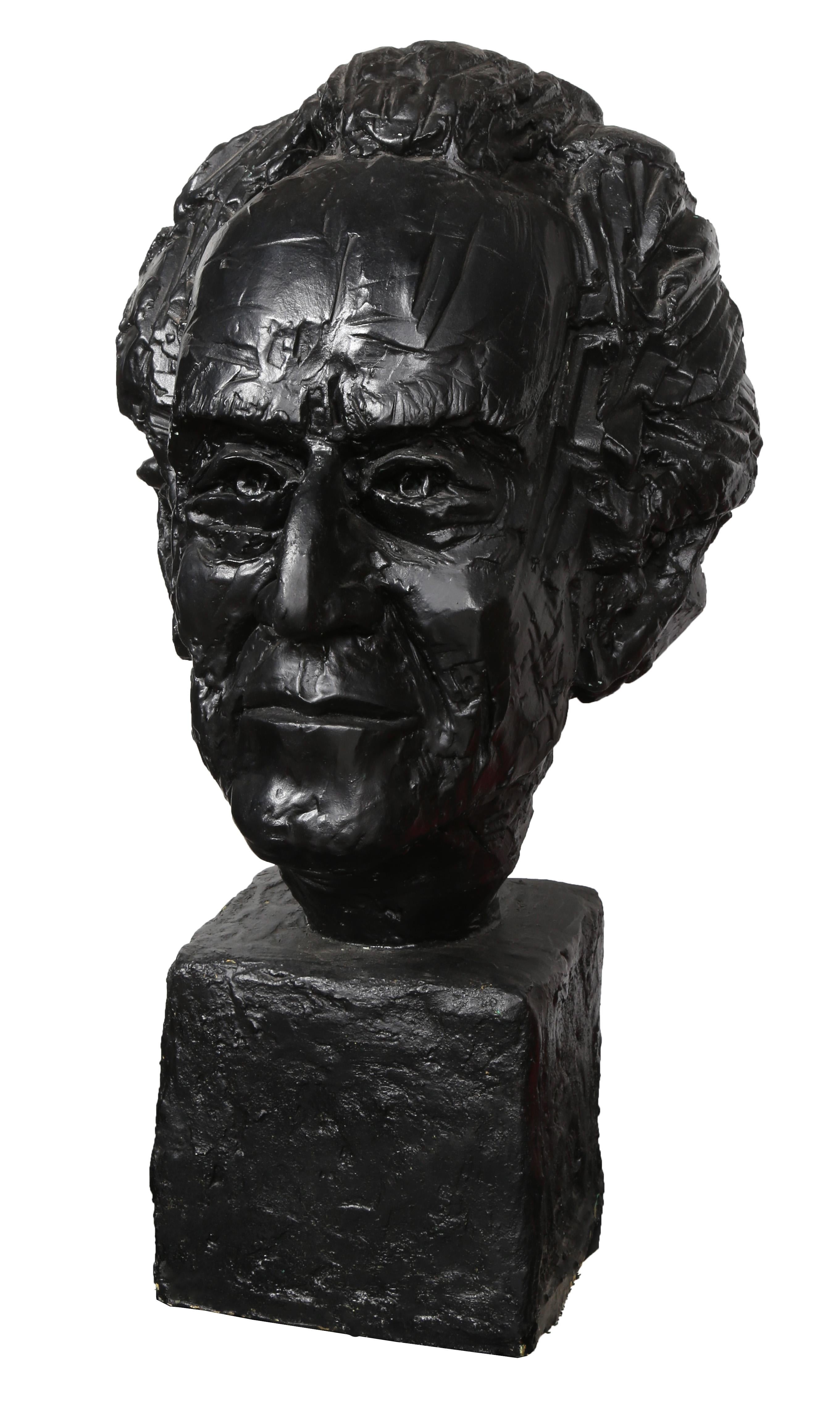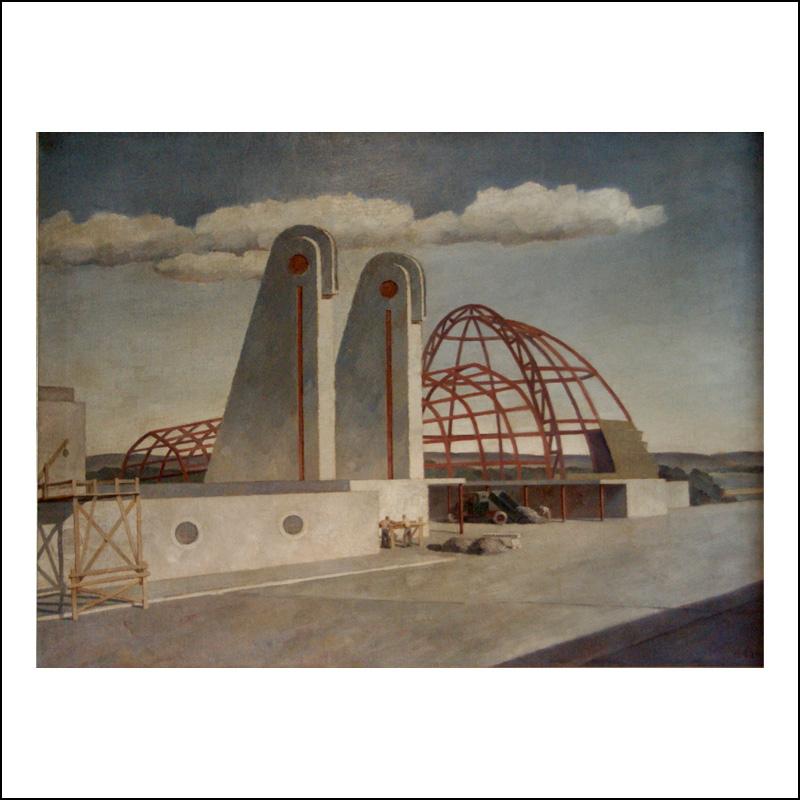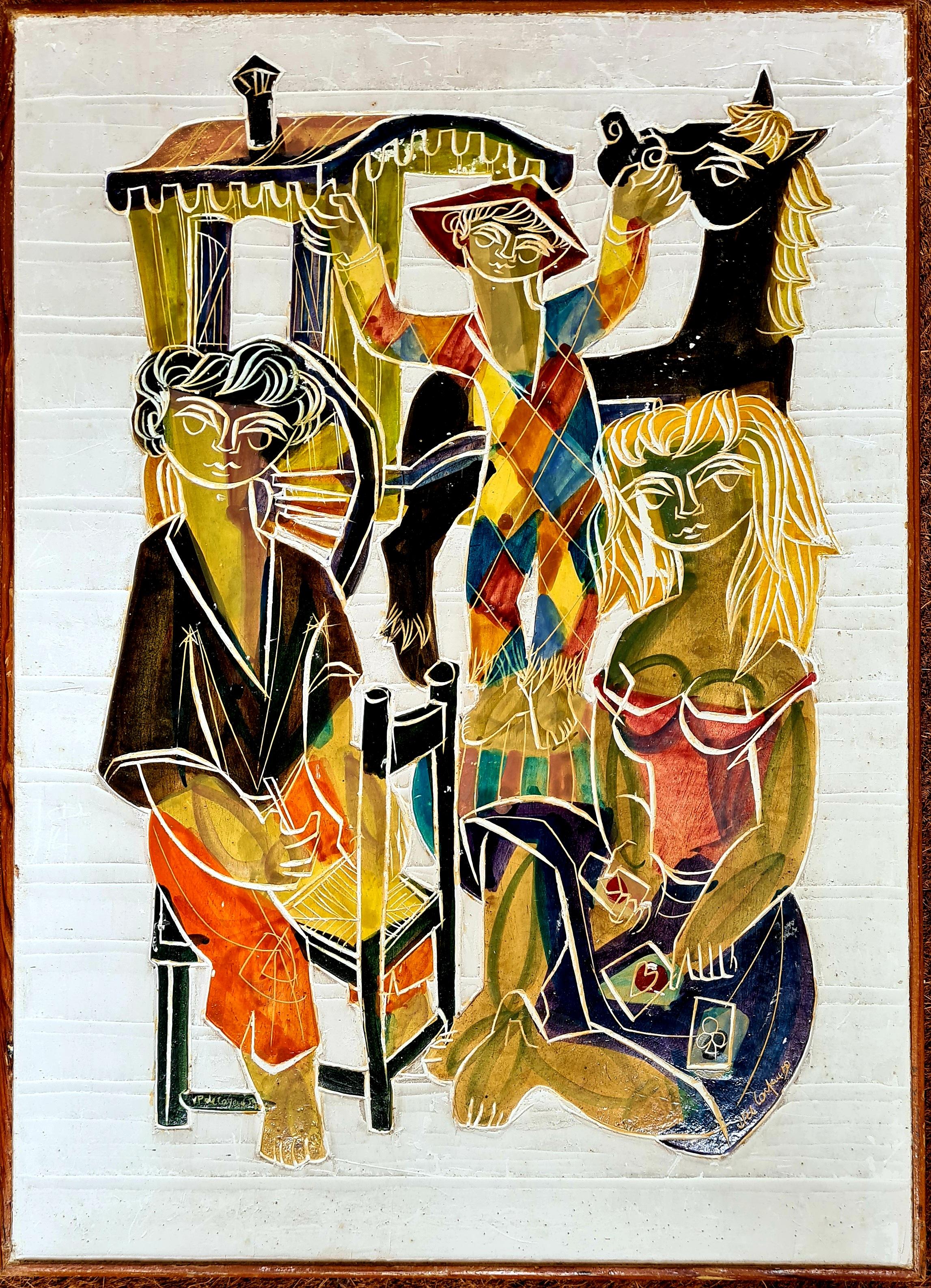Items Similar to French Painted Maquette for Sculpture Judaica Klezmer Musician
Want more images or videos?
Request additional images or videos from the seller
1 of 9
Mane KatzFrench Painted Maquette for Sculpture Judaica Klezmer Musician
About the Item
Mane-Katz (1894-1962) maquette plaster relief for bronze sculpture. (it is made from sort of composite material and then painted or colored from the casting. there is no foundry mark or info. it is signed Mane Katz verso but I do not know if it is the artist's hand.
Emmanuel Mané-Katz (Hebrew:מאנה כץ), born Mane Leyzerovich Kats (1894–1962), was a Litvak painter born in Kremenchuk, Ukraine, best known for his depictions of the Jewish shtetl in Eastern Europe.
Mane-Katz moved to Paris at the age of 19 to study art, although his father wanted him to be a rabbi. During the First World War he returned to Russia, at first working and exhibiting in Petrograd; following the October revolution, he traveled back to Kremenchuk, where he taught art. In 1921, due to the ongoing fighting in his hometown during the civil war, he moved once again to Paris. There he became friends with Pablo Picasso and other important artists, and was affiliated with the art movement known as the School of Paris; together with other outstanding Jewish artists of that milieu, he is sometimes considered to be part of a group referred to specifically as the Jewish School of Paris. Includes painters Jankel Adler, Arbit Blatas, Marc Chagall, Jacques Chapiro, Michel Kikoine, Pinchus Kremegne, Sigmund Menkees, Jules Pascin, Issachar Ryback, Jacques Lipchitz,Chana Orloff, and Ossip Zadkine. Ecole de Paris
In 1931, Mane-Katz's painting The Wailing Wall was awarded a gold medal at the Paris World's Fair. Early on, his style was classical and somber, but his palette changed in later years to bright, primary colors, with an emphasis on Jewish themes. His oils feature Hassidic characters, rabbis, Jewish musicians, beggars, yeshiva students and scenes from the East European shtetl.
Mane-Katz made his first trip to Mandate Palestine in 1928, and thereafter visited the country annually. He said his actual home was Paris, but his spiritual home was Eretz Yisrael, the Land of Israel.
Mane-Katz left his paintings and extensive personal collection of Jewish ritual art to the city of Haifa, Israel. Four years before his death, the mayor of Haifa, Abba Hushi, provided him with a building on Mt. Carmel to house his work, which became the Mane-Katz Museum. The exhibit includes Mane-Katz's oils, showing a progressive change in style over the years, a signed portrait of the artist by Picasso dated 1932 and a large collection of Jewish ritual objects.
In 1953, Mane-Katz donated eight of his paintings to the Glicenstein Museum in Safed, whose artists quarter attracted leading Israeli artists in the 1950s and 1960s, and housed some of the country's most important galleries.
- Creator:Mane Katz (1894 - 1962, American)
- Dimensions:Height: 19 in (48.26 cm)Width: 11 in (27.94 cm)Depth: 2.75 in (6.99 cm)
- Medium:
- Movement & Style:
- Period:
- Condition:minor chips to verso possibly original to piece.
- Gallery Location:Surfside, FL
- Reference Number:1stDibs: LU38213119162
About the Seller
4.9
Platinum Seller
These expertly vetted sellers are 1stDibs' most experienced sellers and are rated highest by our customers.
Established in 1995
1stDibs seller since 2014
1,547 sales on 1stDibs
Typical response time: 1 hour
- ShippingRetrieving quote...Ships From: Surfside, FL
- Return PolicyA return for this item may be initiated within 3 days of delivery.
More From This SellerView All
- Texas Artist David Pryor Adickes John F Kennedy Bas Relief Painted SculptureLocated in Surfside, FLDavid Pryor Adickes American (b. 1927) John F. Kennedy bas-relief plaster relief sculpture in artists frame incised signature lower center. with gold stars...Category
20th Century American Modern Figurative Sculptures
MaterialsPlaster, Wood, Paint
- Helen Shirk Sculpture Hand Crafted Studio Vessel, Copper Patina, Colored PencilsLocated in Surfside, FLTitle: Red Pod, CV110V, San Diego, 1997 Fabricated, hammered copper, colored pencils, patina. This is not signed. It bears a label on the interior and the artist has kindly confirmed the attribution to me. Helen Shirk...Category
1990s American Modern Abstract Sculptures
MaterialsCopper
- Ceramic Plate by Master Art Forger David Stein after Pablo Picasso VallaurisLocated in Surfside, FLApres Pablo Picasso (bears a pseudo signature recto) Hand signed David Stein, dated 1979 verso. Figural painted porcelain or ceramic serving dish, oval form. Dimensions: 18" X 14 David Stein (born Henri Haddad, 1935, Alexandria, Egypt – died 1999, Bordeaux, France) was an artist (notorious art forger) who, until 1966, had been frequently sentenced for theft by the French courts before becoming an art forger and art dealer with 15 aliases. Stein often copied paintings in the style of the masters. For example, he studied Marc Chagall, Matisse, Braque, Paul Klee, Joan Miró, Pablo Picasso, Jean Cocteau and Rouault, in order to copy their color scheme and inspirations. In 1967 Marc Chagall notified authorities of forgeries of his work hanging in a New York gallery, and Stein was arrested. Art dealers refused to cooperate with the prosecution because it would have incriminated them and made their expertise in the art field questionable. Some art collectors refused to give up their paintings as evidence. Stein was convicted of six counts of art forgery and grand larceny. During his prison term, Joseph Stone, the judge who arrested him, brought him to his office to paint. He remained a good friend of the Stein family long after Stein completed his jail sentence. In 1989 he discovered that Stein never stopped making forgeries. After Stein had served his prison term in the United States, he was deported to France where he served another term. Prison authorities allowed him to make further paintings, although now using his own name. In 1969 a London gallery sold some of these paintings. After Stein was released, he returned to painting, this time selling his paintings under his own name to put a mask on his real activities. The book Three Picasso's Before Breakfast (Mémoirs of an Art Forger's Wife) by Anne Marie Stein as told to Georges Carpozi Jr (Hawthorn Book Inc) was written by David's life partner Anne-Marie about their experiences in the art world. In the mid 1980s director Gil Cates gave his agent Arthur Axelman at William Morris a copy of the book which had been written without Stein's involvement. Axelman set out to find Stein and after several years he located him in Manhattan. Stein became an Axelman client and friend. While deals at HBO and ABC did not lead to production of a film, Axelman introduced Stein to Keith Carradine and Alan Rudolph, director of the movie "The Moderns" with ultimately starred John Lone, Géraldine Chaplin, Keith Carradine and Linda Fiorentino. The film was set in the Paris of the '20s although filmed in Montreal. Stein appeared in the film as an art critic and provided all of the art. A minor concern was a scene where a painting in the style of Matisse and Modigliani was to be burned on camera and a Modigliani destroyed by knife. No one cared to destroy any of Stein's copies, "Just good for the camera" say Stein. but a William Morris assistant for agent Axelman suggested making large format copies of the works to be destroyed. Stein refused and during the scene actor John Lone destroyed the Paintings. Stein was living in France after his troubles with the US immigration who had told him to leave US territory in 1988. He met the French photo...Category
1970s Modern Figurative Sculptures
MaterialsEnamel
- Large Oil Painting Of Cartoony Camouflage Tank in Illustration StyleBy Seymour ChwastLocated in Surfside, FLSeymour Chwast (born August 18, 1931) is an American graphic designer, illustrator, and type designer. Chwast was born in Bronx, New York, and graduated with a Bachelor of Fine Arts from Cooper Union in 1951. With Milton Glaser, Edward Sorel...Category
20th Century American Modern Figurative Paintings
MaterialsPaint, Board
- Girl on a Buick Painting on Metal Cut Out Sculpture Wall HangingBy Seymour ChwastLocated in Surfside, FLSeymour Chwast, B. 1931, American, 'Girl on a Buick', Painted Sheet Metal. A label on the reverse reads: "Seymour Chwast, 'Girl on a Buick', Metal Cut-Out, $2,000" Provenance: Bachelier-Cardonsky Gallery, Kent CT Seymour Chwast (born August 18, 1931) is an American graphic designer, illustrator, and type designer. Chwast was born in Bronx, New York, and graduated with a Bachelor of Fine Arts from Cooper Union in 1951. With Milton Glaser, Edward Sorel, and Reynold Ruffins, he founded Push Pin Studios in 1954. Often referred to as "the left-handed designer," Chwast's unique graphic design melded social commentary and a distinctive style of illustration. Today, he continues to work and is principal at The Pushpin Group, Inc. in New York City. In 1979, he was hired by McDonald's to design on the first box for their Happy Meals. He is the font designer of Chwast Buffalo, Fofucha, Loose Caboose NF, and Weedy Beasties NF. He is a member of Alliance Graphique International (AGI). In the pantheon of American (nay, world) illustration, he stands, albeit slightly shorter and a little more rumpled, beside N.C. Wyeth, J. C. Leyendecker, and Normal Rockwell...Category
20th Century American Modern Figurative Paintings
MaterialsMetal
- Plaster Sculpture Relief Art Deco Plaque WPA Artist Peace Swords to PloughsharesBy George AaronsLocated in Surfside, FLSize includes wood mounting. George Aarons (born Gregory Podubisky, in St. Petersburg, Russia, 1896 - died in Gloucester, Massachusetts 1980) was a distinguished sculptor who lived and taught in Gloucester, Massachusetts, for many years until his death in 1980. He had, many students in the area and he designed Gloucester's 350th Anniversary Commemorative Medal. Aarons moved from Russia to the United States when he was ten. His father was a merchant. He began taking drawing classes during evenings at Dearborn Public School in Boston as a teenager and went on to study at the Boston Museum of Fine Arts in 1916. Aarons later moved to New York City to study with Jo Davidson, and other Paris-trained masters at the Beaux-Arts Institute. He eventually returned to the Boston area and established studios in Brookline and Gloucester, Massachusetts. During his lifetime, he was recognized internationally and won several prestigious awards. Aarons had studios in Brookline, Massachusetts and Gloucester, Massachusetts where he produced large bronze and marble figures and wood carvings. He produced several projects for the Works Progress Administration including a group of three figures for the Public Garden (Boston), a longshoreman, fisherman and foundry worker, as well as a large relief (1938) for the South Boston Housing Project and façade of the Baltimore Hebrew Congregational Building (1956). His works are at the Museum of Art in Ein Harod, Israel; Fitchburg Art Museum in Massachusetts, Musée de St. Denis in France; Hilles Library at Radcliffe College in Cambridge, Massachusetts; and Hillel House at Boston University in Massachusetts. He did reliefs for Siefer Hall at Brandeis University in Waltham, Massachusetts (1950); Edward Filene (the founder of Filene's Department Store and a philanthropist) on the Boston Common; Fireman's Memorial in Beverly, Massachusetts; a memorial to Mitchell Frieman in Boston; the U.S. Post Office in Ripley, Mississippi; and at the Cincinnati Telephone Building; the Combined Jewish Philanthropies building in Boston (1965); and a commemorative medal for the 350th Anniversary of the City of Gloucester, Massachusetts (1972). Characteristic of his era, George Aarons was among the foreign-born American sculptors of the early 20th century who started their careers as academicians and evolved into modernists and increasingly abstract artists. Over thirty pieces spanning the length of this sculptor's career were featured in this exhibition, including work in various medium bronze, wood and original plasters. Like his contemporaries, Aarons experimented with direct carving in wood, and he was one of the few academically trained sculptors who consistently cut his own works in marble. His early work was classically inspired figurative work, along with sensitive portraits. Some of his most powerful sculpture comes from his middle period, when he worked through his emotional pain following the global realization of the Jewish Holocaust. He depicted humanity deep anxiety over this tragedy with figures that are at once symbolically charged and movingly beautiful. Aarons late work consists of radically simplified forms that continue to reference the human form and often are carved directly in wood and stone. Aarons summered and taught classes on Cape Ann for many years before moving to Gloucester full-time with his wife about 1950. While Aarons is best known locally for his domestic-scale works, he also executed numerous monumental, public commissions that can be found throughout the United States in cities such as Washington, D.C.; Baltimore, Maryland; and Cincinnati, Ohio; as well as in France and Israel. As noted in a Gloucester Daily Times Article, Aarons wanted his sculptures to honor the struggles and nobility of people and rail against the evil done against them. And that was why, even as his work grew more and more abstract, stylized and simplified, he never left behind the form of the human figure that had been his focus from his earliest works. Aarons told the Gloucester Daily Times in September 1954 that he found it hard to remember at just what age he started studying art, but he recalled that the nude model had to partially dress when he was in class because he was so young. He initially studied painting and drawing at the museum school, but he once said he became fascinated by sculpture when he met an established sculptor at the Copley Society in Boston who invited Aarons to his studio and offered him some clay to "play around" with. After he graduated, he apprenticed under sculptors Richard Brooks, Robert Baker and Solon Borglum. He worked as a carpenter, shipbuilder, dishwasher and chimney sweep. He fashioned architectural decorations, including figures for fountains and now and then a few commissioned portraits. He returned to Boston by the early 1920s and began to exhibit his own works and get commissions for portraits, fountains and reliefs. His sculptures from this time are dreamy and romantic in the realistic, academic style of the time. A painted portrait of the young Aarons that is included in the North Shore Arts Association exhibit shows a determined fellow with dark brown hair, a suit and bow tie. However, in 1922, this determined young artist was living with his parents on Calder Street in Dorchester. In the 1930s, Aarons adopted the streamlined, monumental style of the socialist works of the time. Aarons made money, as he would all his life, from commissions, selling his personal work and teaching sculpture, but the Depression of the 1930s was tough for everyone. So Aarons found work though the federal Works Progress Administration, one of Franklin Roosevelt's New Deal programs. He received his first major commission when he was asked to create a public sculpture for the South Boston Harbor Village public housing project around 1937. He was elevated to the position of supervisor for the project and received a corresponding $5 pay increase to make his weekly salary $32. The raise convinced him he was fit to marry and he proposed to Gertrude Band, an attractive brunette dancer whom he had been dating for more than a year. They were married before the Harbor Village project was dedicated on Labor Day 1938. Aarons' design featured a brawny, larger-than-lifesize fisherman, longshoreman and a laborer flanked by a boy and girl at either end to portray the children who would live in the apartments. Aarons elected to do the piece in cast stone to employ carpenters and laborers as well as craftsman for a total of 10 men. In his sculpture, Aarons focused more and more on the theme of oppressed people as he worried about the spread of fascism and Nazism during the 1930s, World War II and after. He had done pieces during the mid-1930s about the oppression of African-Americans, including "Negro Head," which is in the North Shore Art Association retrospective. After the war, he also delved into Jewish themes and became increasingly known as an important Jewish artist, leading to commissions from Jewish organizations across the country and abroad. "He gets into raw emotion. Some people describe him as an expressionist because of the emotion (in his work)," Reynolds says. But Aarons, also sculpted sensual sexual nudes...Category
20th Century Art Deco Figurative Sculptures
MaterialsPlaster, Wood
You May Also Like
- Bust of a Man, Sculpture by Paul von RingelheimBy Paul von RingelheimLocated in Long Island City, NYArtist: Paul Von Ringleheim, Austrian/American (1933 - 2003) Title: Bust - II Year: Circa 1970 Medium: Painted Plaster Size: 26 x 11 x 15.5 inchesCategory
1970s American Modern Figurative Sculptures
MaterialsPlaster, Paint
- Bust of Alberto Giacometti, Sculpture by Paul von RingelheimBy Paul von RingelheimLocated in Long Island City, NYArtist: Paul Von Ringelheim, Austrian/American (1933 - 2003) Title: Bust of Alberto Giacometti Year: Circa 1970 Medium: Painted Plaster Size: 29.5 x 13 x 17.5 inchesCategory
1970s American Modern Figurative Sculptures
MaterialsPlaster, Paint
- 1, 000 piece Museum Quality Collection of Art & Objects from NYC 1939 Worlds FairBy Harry LaneLocated in New York, NY1,000 piece Museum Quality Collection of Art & Objects from NYC 1939 Worlds Fair Harry Lane (1891-1973) "1939 World’s Fair Construction," 30 x 40 inches, Oil on canvas, signed lower...Category
1930s American Modern Landscape Paintings
MaterialsPlaster, Photographic Paper, Canvas, Oil
- Mid Century Sgraffito, Saltimbanque and the Card Player, Circle of Picasso.Located in Cotignac, FRMid 20th Century sgraffito work on plaster by Jean Pierre de Cayeux. The work is signed and dated on the skirt of the card player, bottom right, and on the stretcher of the chair, bo...Category
Mid-20th Century Modern Figurative Sculptures
MaterialsEnamel
- Future Relic 05: TelephoneBy Daniel ArshamLocated in Miami, FLDaniel Arsham Future Relic 05: Telephone, 2016 Sold in mint condition - in original box with custom foam support and gloves. Plaster and crushed glass sculpture 4.7 x 8.5 x 9 in Edit...Category
2010s Modern Abstract Sculptures
MaterialsGlass, Plaster
- Daniel Arsham FUTURE RELIC 07 CASSETTE PLAYER Limited Sculpture Sony Walkman 90sBy Daniel ArshamLocated in Madrid, MadridDaniel Arsham - FUTURE RELIC 07 - CASSETTE PLAYER Date of creation: 2017 Medium: Plaster and crushed glass Edition number: 476/500 Size: 12.7 × 14.6 × 14 cm Condition: In mint condi...Category
2010s Modern Figurative Sculptures
MaterialsGlass, Plaster





